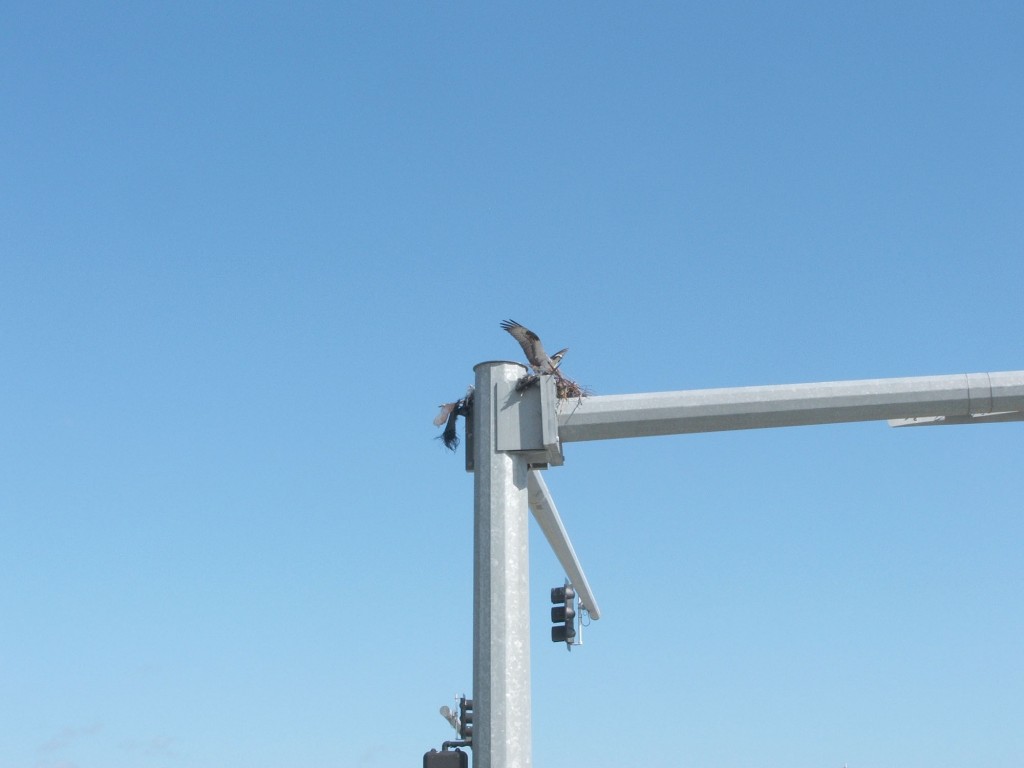An interesting sight I saw on a recent trip to Florida was an osprey nest that had been built on top of a traffic signal at a very busy intersection. The interesting fact about this nest is that the osprey had been booted from her original nest by an owl. You might wonder how this could happen, since the adult osprey weighs close to 5 pounds with a wing span of 50 to 71 inches compared to the owl weighing in at 3 pounds with a wing span of only 40 to 60 inches.
This osprey had originally built her nest high on top of one of the lights at the local baseball field where I imagine she felt safe and away from danger, as well as taking advantage of the warmth from the light. But now the great horned owl has taken over her home. Stadium officials cannot do anything with the nest because the owls are federally protected as a migratory species. Experts say it is extremely rare to see the reclusive nocturnal species, one of North America’s largest, in such a public place. Yet, she is perched atop the platform that was once used by the osprey, above the right-field lights. Last year the osprey made her nest over the left-field lights and the owl did not bother her there. There is some concern about twigs, prey parts and bird droppings falling on the fans, but they have never come close to any of the fans.
Building a nest is beneath the great horned owl. They let ospreys, hawks and crows do that kind of grunt work, then they rudely boot them from the nest. This devilish-looking squatter seems to have nudged the osprey to the traffic light about two blocks away. A gnarl of twigs dangles precariously from the nest where this predator had a bird’s-eye view of spring training that went on below. This owl can hear a mouse’s heartbeat from 10 yards away. Despite its sensitivities, the owl with the constant scowl perches motionless, unmoved by the roar of the cheering fans, the pops of bat-cracking line drives, the organ playing or any other sounds of baseball. She is not fazed by players rounding bases or people carrying hotdogs, even though she is highly attuned to motion.
An owl’s eyes are 10 times as light sensitive as human eyes. They can snatch a slithering snake in the grass at night from hundreds of feet up, swallow a small rabbit whole and eat squirrels, muskrats and skunks. Not sure how long she will be on this nest since the young owls can fly in 10 weeks, but the male and female owl will care for the young for five months. Officials at the ballpark have used decoy owls to spook off other birds, but the owl does not flinch. Officials have said that they will not try to keep her away next year.
That is why the osprey had to rebuild her nest in a different area. The osprey was just no match for the cunning owl. The osprey is from the hawk and eagle family and is a fish-eating bird of prey. She tolerates a variety of habitats, nesting in any location near a body of water that provides a food supply. It is found on all continents except Antarctica. The osprey and the owl have some similarities in the fact that they are the only two birds of prey whose outer toes are reversible, allowing them to grasp their prey with two toes in front and two behind. This is very helpful when grasping a slippery fish. Fish make up most of its diet and ospreys can be as large as 14 inches in length and weighing up to 68 ounces. Their vision is so good that they can detect underwater objects in the air from as high up as 130 feet above the water. It will then hover before plunging feet first into the water and it can close its nostrils to keep out the water during these dives. In addition to fish, the osprey will eat rodents, rabbits, hares, amphibians, other birds and small reptiles. The osprey mates for life and the female lays two to four eggs within a month. The eggs are incubated for five weeks and the chicks weigh only 2 ounces. The typical lifespan is seven to 10 years, although there are records of individuals who have lived to the age of 20 to 25 years.
So you see there are a few similarities between the osprey and the owl besides liking the same spot for a nest. The owl won this contest, the osprey had to move out and adjust to the change, but the owl ‘didn’t give a hoot!’












